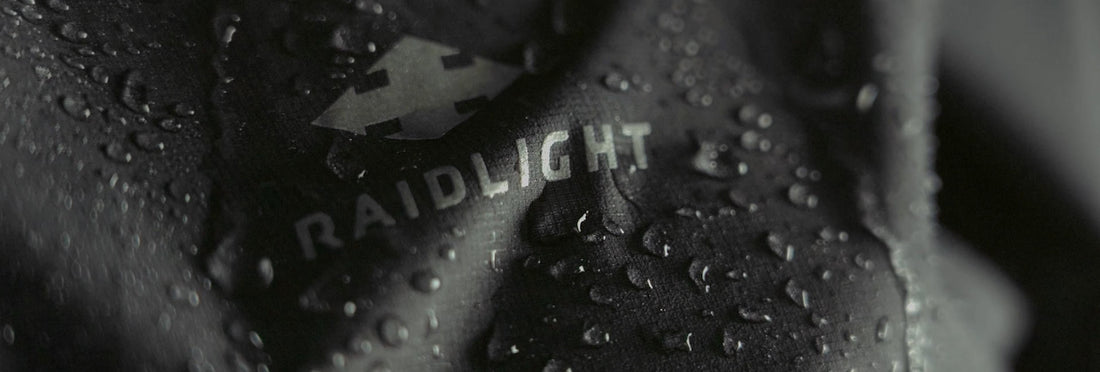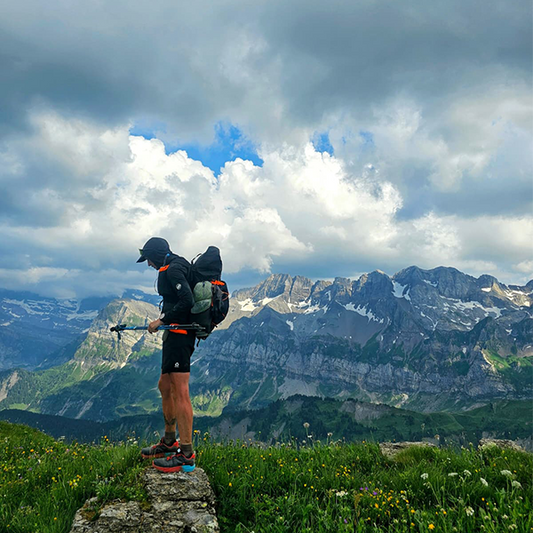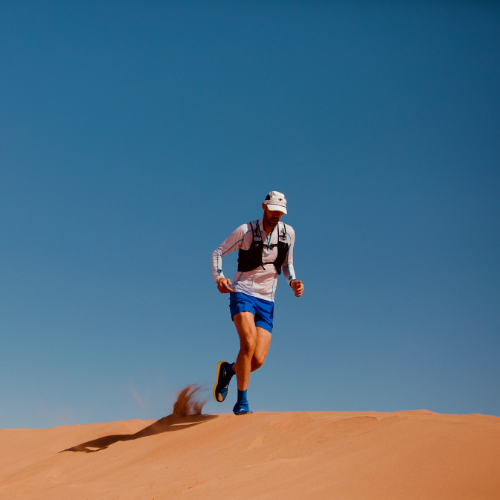Waterproofing and breathability are terms often used in descriptions of technical clothing, but few people really know what they mean. Although it's not very complicated, it's still necessary to go through a few technical explanations that will shed light on these concepts and help you select the garment best suited to your needs.

Understanding waterproofing and breathability performance indices
The waterproofing and breathability of a trail jacket are the two criteria to look out for when buying a rain jacket equipped with specific membranes.
Breathability
Breathability is the ability of a fabric to evacuate water vapour. A fabric with good breathability limits the condensation of water vapour inside the garment. It therefore facilitates the evacuation of perspiration and keeps the body dry. There are several ways to measure the breathability of a product.
Depending on the weather conditions and the clothing worn, our body regulates its temperature by evacuating water through perspiration. Moist air from outside can also penetrate our clothing. It is therefore essential to wear breathable clothing, otherwise the moisture created will be trapped in the fabric, which will then cool you down. Breathability allows water vapour to escape, keeping you dry.
There are several ways of measuring a product's breathability. Here are the two most commonly used measurements:
The MVP (Moisture Vapour Permeability) measurement calculates the amount of water (in the form of vapour) that the fabric lets through in 24 hours. The higher the value, the more breathable it is. MVTR is expressed in gr /m2 / 24 h:
MVP 5 000 = garment not very breathable
MVP 10 000 = breathable clothing
MVP 20 000 = garment with very good breathability
MVP 40 000 = garment with excellent breathability
MVP 60 000 = extremely breathable garment
This index is used by most equipment manufacturers.
The RET (Resistance Evaporative Transfer) index measures a fabric's ability to allow water vapour generated by the body (perspiration) to escape. Since RET is a resistance index, the lower it is, the more breathable the garment.
RET above 20: not breathable
RET between 12 and 20: slightly breathable
RET between 6 and 12: breathable
RET less than 6: very breathable
This index is mainly used by American brands.
Waterproofing
Waterproofing is the ability of a fabric to prevent water penetration. A fabric can be made waterproof by adding a membrane or coating. To measure the impermeability of a fabric, it is placed under a tube (column) filled with water, and the height of the first drops of water that pass through the fabric is calculated. The higher the water level, the more impermeable the fabric.
The Schmerber is the unit used to measure impermeability.
1 Schmerber = 1 column of water of 1 mm. A garment with a Schmerber value of 10,000, i.e. 10,000 mm, will withstand 10 m of water! A garment is considered perfectly waterproof from 20,000 Schmerber.
To give a garment a waterproof rating, it is subjected to the hydrostatic pressure of a column of water during the test. The test stops when the water begins to penetrate the garment. In these cases, the height of water that the garment was able to withstand is measured. This value, given in millimetres of water column, expresses the degree of waterproofness of the fabric. This test method (ISO 811) has even become a standard.
For example: 10,000 Schmerber = 10,000mm of water column = often noted as 10K.
A waterproof jacket is necessary for all outdoor activities and is generally thin, compact and lightweight, perfect for easy transport.
Understanding the difference between waterproof and water-repellent
A waterproof product protects you from heavy rain, whereas a water-repellent product only protects you from drizzle. Water repellency is the property of a fabric on which water slides and does not penetrate.
Water-repellent products do not have membranes. Water-repellent fabrics are fabrics to which a product has been applied that repels water. The water then runs off in droplet form and cannot impregnate the fabric, so breathability is preserved.
However, water-repellent fabrics are not designed to withstand immersion or heavy rain. What's more, over time, with wear and tear and washing, the water-repellent treatment wears off.

Our MP+ membrane
In textiles, a membrane is a very thin, flexible layer that insulates one body from another. For example, in a waterproof trail jacket, the membrane makes it waterproof.
The performance of a membrane is generally measured according to two criteria: breathability and waterproofness. At Raidlight, we use MP+® technology (similar to Gore-Tex), which is both waterproof and breathable. Every product equipped with the MP+ membrane is durably waterproof, windproof and breathable, whatever the weather conditions. This means that water can't penetrate and cold winds can't blow through, but perspiration can still escape.
The MP+® membrane is a technology specially designed to protect riders from rain and all types of weather. The characteristics of the MP+® membrane are :
- High level of waterproofing
- High level of breathability
- Windproof
- Resistance to cold
- Durability
The MP+® membrane is a solid, non-microporous membrane. As a result, it is totally waterproof, breathable and windproof. It's made from a hydrophilic polyurethane film with exceptional properties: thanks to its physico-chemical properties, it provides perfect comfort during your outings.
To give a garment a waterproof rating, it is subjected to the hydrostatic pressure of a column of water during the test. The test stops when the water begins to penetrate the garment. In these cases, the height of water that the garment was able to withstand is measured. This value, given in millimetres of water column, expresses the degree of waterproofness of the fabric. This test method (ISO 811) has even become a standard.
For example: 10,000 Schmerber = 10,000mm of water column = often noted as 10K.
A waterproof jacket is necessary for all outdoor activities and is generally thin, compact and lightweight, perfect for easy transport.
Understanding the difference between waterproof and water-repellent
A waterproof product protects you from heavy rain, whereas a water-repellent product only protects you from drizzle. Water repellency is the property of a fabric on which water slides and does not penetrate.
Water-repellent products do not have membranes. Water-repellent fabrics are fabrics to which a product has been applied that repels water. The water then runs off in droplet form and cannot impregnate the fabric, so breathability is preserved.
However, water-repellent fabrics are not designed to withstand immersion or heavy rain. What's more, over time, with wear and tear and washing, the water-repellent treatment wears off.

Products with the MP+ membrane offer a three-tier protection system to protect you from the weather, while ensuring optimum comfort: waterproofing, breathability and wind protection.
Find out more about our products designed with the MP+ membrane by clicking here.











1 comment
Your website is very inspiring with high-quality content. We are sure that you will find additional useful information on our website. Come on, visit us at Garmen Bandung and we can collaborate with each other.
Warm Regard.